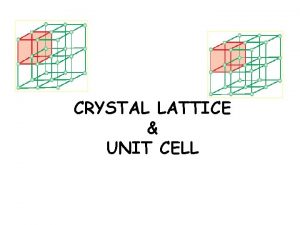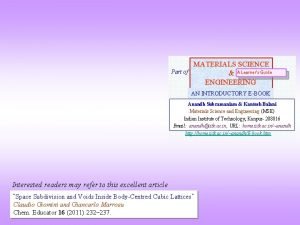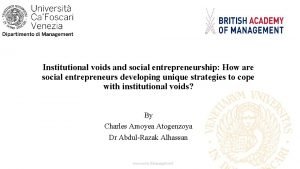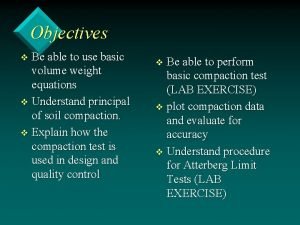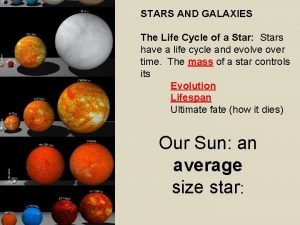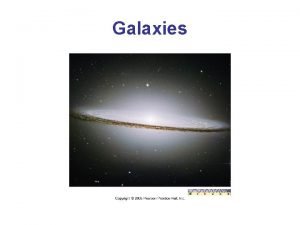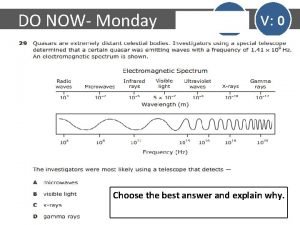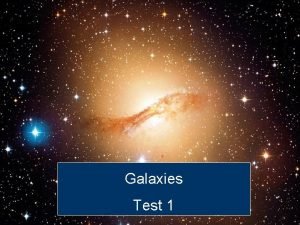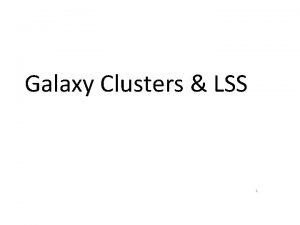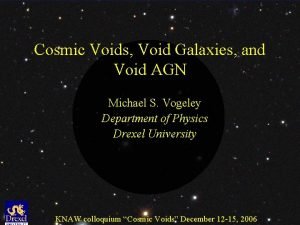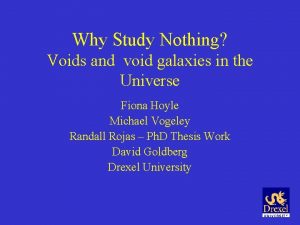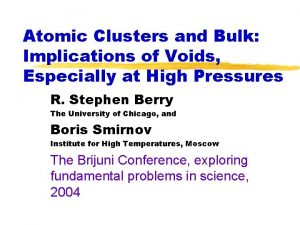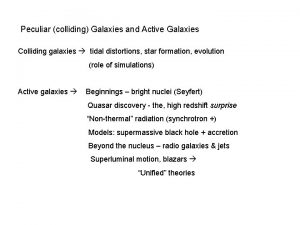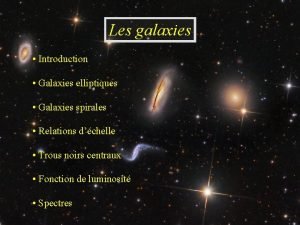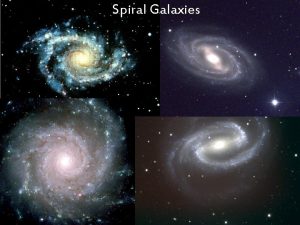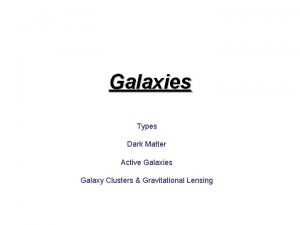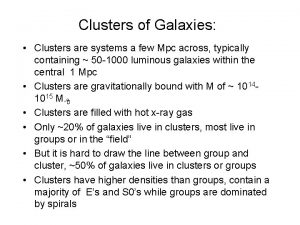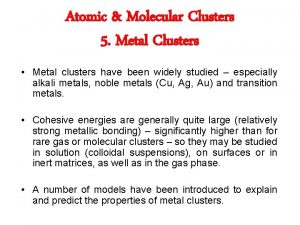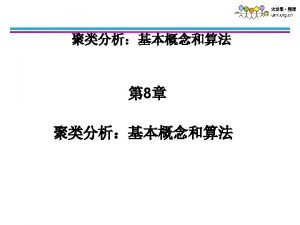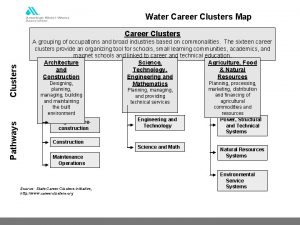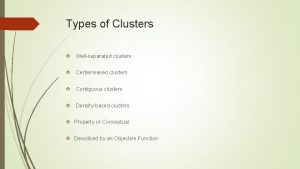Evolution of galaxies and clusters in voids and



















- Slides: 19

Evolution of galaxies and clusters in voids and superclusters Jaan Einasto Maret Einasto, Enn Saar, Erik Tago, Gert Hütsi, Juhan Liivamägi, Ivan Suhhonenko - Tartu Observatory Volker Müller, Alexander Knebe, Stefan Gottlöber - AIP Douglas Tucker - Fermilab Amsterdam 14. 12. 2006

Overview n n n Peebles question: why voids are empty? Numerical modeling of structure evolution; wavelet decomposition Numerical modeling: evolution in void, filament, supercluster environment Numerical modeling: the role of perturbations of different wavelength SDSS & 2 d. F data: voids, filaments, superclusters Conclusions

Structure of the Supercluster-void network Galaxies are concentrated to long essentially 1 -D filaments; rich filaments form superclusters, poor filaments cross low-density regions. Concentration of galaxies to filaments is impossible in a later epoch: galaxies must form in filaments (Einasto, Saar, Joeveer 1977, 1980).

Evolution of under- and over-density regions Over-densities contract until collapse, the formation time is earlier for higher over-densities. Forming objects have sizes ~ 1 Mpc/h Under-densities expand, local density decreases, but never reaches zero level – analytic solution by Saar (1979)

Modeling the evolution in various environment Models: LCDM 256 (200) Mpc/h box, 256^3 particles, z = 10, 5, 2, 1, 0. 5, 0 Density field found with 2 smoothing lengths 8 Mpc/h – global environment 0. 8 Mpc/h – local environment Assumptions: 1. The mixing between large-scale environment regions is small 2. Galaxies form only there where local density exceeds the mean density 3. Unclustered matter In under-dense regions is primordial Simulation volume is divided into 4 regions according to global density: 1. Supercluster regions, containing 30 % of matter 2. Rich filament region 30 % 3. Poor filament region 30 % 4. Void region 10 %

Main structural elements form early at z > 10 as low-density systems, at z = 5 they have welldefined structure. During the evolution clusters & filaments merge. z = 5, z = 2 z = 1, z = 0

Evolution of sizes of cluster particle clouds Clusters/groups at the present epoch were found in high-resolution density field (41060). Positions of cluster particles were located at earlier epochs, and mean radii of particle clouds were found. In SCL core regions the size decreases 5 times (present clusters form via mergers of many subhalos). In void region sizes do not change – groups do not evolve.

Wavelet analysis of the density field We use the ‘a trous wavelet transform. The field is decomposed into several frequency bands, each band contains frequencies twice the previous band, in the range ±√ 2 x main frequency. The sum of these bands restores the original field. We show the decomposition of 1) The model M 256 at present epoch 2) The evolution of waves w 6 and w 4 from z = 10 to z = 0 3) The real density field of SDSS around SCL 126

LCDM 256 Mpc/h Evolution of w 6 wave: z = 0, z = 1 z = 2, z = 5, z = 10 Positions of maxima do not change Amplitudes increase Standing wave

LCDM 256 Mpc/h Evolution of w 4 wave: z = 0, z = 1 z = 2, z = 5, z = 10 Positions of maxima change little. The increase of the amplitude depends on the location in respect to large waves: near maxima increase much, near minima increase little.

Numerical experiment of the role of waves of different length Supercluster-void network scale is determined by largest waves present. In the absence of large & medium scale perturbations galaxies & groups form everywhere – there are no superclusters & filaments.

SDSS Original L=500 Mpc w 2 w 4 w 5 w 3 w 6

Density perturbations as an acoustic phenomenon If there exists a dominating wavelength (tone), then overtones of this wave are amplified, and intermediate waves not. In the SDSS slice the wave 250 Mpc/h has enhanced amplitude (scale w 5), its 1 st overtone (scale w 4) is also amplified, as well the next 1 st overtone (scale w 3). Superclusters form in regions where large density waves combine in similar high-density phases Superclusters are the richer the larger is the wavelength of phase synchronization

The role of waves of different wavelength Large waves form superclusters and large voids, medium waves form galaxy chains/filaments, short waves form galaxies and groups/clusters: rich near maxima of large waves, poor near minima of large waves. No galaxy formation takes place near minima of large and medium waves, since the overall density is here below the mean density level.

Evolution of under- and over-density regions Over-densities contract until collapse, the formation time is earlier for higher over-densities. Forming objects have sizes ~ 1 Mpc/h Under-densities expand, local density decreases, but never reaches zero level – analytic solution by Saar (1979)

Conclusions I n n n Superclusters form in regions where large density waves combine in similar high-density phases Superclusters are the richer the larger is the wavelength of phase synchronization Voids form in regions where large density waves combine in similar low-density phases

Conclusions II n n In supercluster regions the dynamical evolution is rapid, the primordial population is consumed rapidly, and the later evolution consists of the transition of poor galaxy systems to rich clusters In void regions the mean density decreases continuously, DMhalos in poor filaments evolve very little, and most particles remain primordial (non-clustered) Galaxy-sized density perturbations in void regions between filaments had always local density below the threshold to start galaxy formation In filament regions the evolution is intermediate: about one quarter of matter is still in primordial stage, the growth of cluster population is slow, most of matter is in galaxy population.

Luminosity & multiplicity functions of 2 d. F, SDSS & Mill superclusters Left: Integrated luminosity function of 2 df, SDSS & Mill simulation superclusters. Luminosity is expressed in units of the mean luminosity of richness class 1 superclusters. Right: Multiplicity function of observed (2 d. F+SDSS) superclusters, Abell cluster superclusters & Mill superclusters. Multiplicity is defined as the number of rich clusters of galaxies in the supercluster. The number of very rich superclusters is much larger than model predicts.

LCDM z = 0: original L= 256 Mpc, w 2, w 3 w 4, w 5, w 6
 Evolution of galaxies
Evolution of galaxies Erroneous cubic cell
Erroneous cubic cell Materials science tetrahedron
Materials science tetrahedron Institutional voids
Institutional voids How to plot zero air voids curve
How to plot zero air voids curve Oblique lattice
Oblique lattice Waves are produced by stars and galaxies
Waves are produced by stars and galaxies Chapter 30 galaxies and the universe
Chapter 30 galaxies and the universe Elliptical galaxy
Elliptical galaxy Life cycle of a galaxy
Life cycle of a galaxy Elliptical galaxies facts
Elliptical galaxies facts E irregulars
E irregulars Era of galaxies
Era of galaxies Milky way galaxy shape
Milky way galaxy shape What are galaxies
What are galaxies Brainpop galaxies quiz answers
Brainpop galaxies quiz answers 4 types of galaxies
4 types of galaxies How are galaxies classified? *
How are galaxies classified? * Tipus de galaxies
Tipus de galaxies Type of galaxy
Type of galaxy

